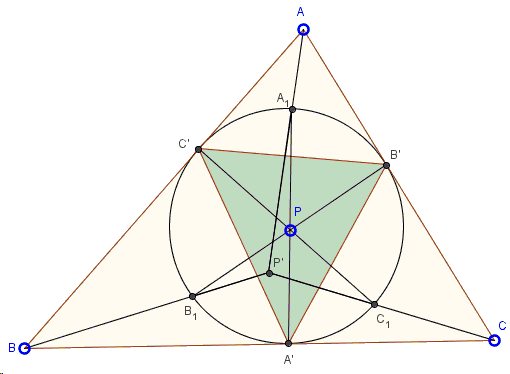Concurrence Not from School Geometry
Sohail Farhangi
17 February, 2013
Let the incircle \(T\), of \(\Delta ABC\) be tangent to the sides at \(A'\), \(B'\), and \(C'\) as shown below. For a point \(P\) in the plane, let \(A'P\), \(B'P\), and \(C'P\) intersect \(T\) at \(A_1\), \(B_1\), and \(C_1\) respectively. Then \(AA_1\), \(BB_1\), and \(CC_1\) concur at a point \(P'\).

The applet below serves a dynamic illustration:
Proof
James Tao recommended to me a proof using the trigonometric form of Ceva's Theorem. First we will use the extended Law of Sines on \(\Delta AA_{1}C'\) and \(\Delta A_{1}C'A'\) to obtain the following equations where \(r\) is the radius of \(T\).
| (1) | \(\displaystyle \frac{C'A_1}{\mbox{sin}(\angle C'AA_{1})}=\frac{AA_1}{\mbox{sin}(\angle AC'A_{1})} \) |
| (2) | \(\displaystyle \frac{C'A_1}{\mbox{sin}(\angle C'A'A_{1})}=2r. \) |
Dividing (2) by (1) gives us the following equation:
| (3) | \(\displaystyle \frac{\mbox{sin}(\angle C'AA_{1})}{\mbox{sin}(\angle C'A'A_{1})}=\frac{2r\mbox{sin}(\angle AC'A_{1})}{AA_{1}}. \) |
A similar analysis for \(\Delta AB'A_1\) and \(\Delta A_{1}1B'A'\) will give us the next equation:
| (4) | \(\displaystyle \frac{\mbox{sin}(\angle B'AA_{1})}{\mbox{sin}(\angle B'A'A_{1})}=\frac{2r\mbox{sin}(\angle AB'A_{1})}{AA_{1}}. \) |
Now dividing (3) by (4) yields another equation:
| (5) | \(\displaystyle \frac{\mbox{sin}(\angle C'AA_{1})\mbox{sin}(\angle B'A'A_{1})}{\mbox{sin}(\angle C'A'A_{1})\mbox{sin}(\angle B'AA_{1})}=\frac{\mbox{sin}(\angle AC'A_{1})}{\mbox{sin}(\angle AB'A_{1})}. \) |
Now note that \(\angle AB'A_{1}=\angle B'A'A_1\) since \(AB'\) is tangent to \(T\), and similarly we have \angle \(AC'A_{1} = \angle C'A'A_1\), which gives us
| (6) | \(\displaystyle \frac{\mbox{sin}(\angle C'AA_{1})}{\mbox{sin}(\angle B'AA_{1})}=\bigg(\frac{\mbox{sin}(\angle C'A'A_{1})}{\mbox{sin}(\angle B'A'A_{1})}\bigg)^{2}. \) |
Finally, we are ready to apply the trigonometric form of (the inverse of) Ceva's theorem:
| (7) | \(\displaystyle \frac{\mbox{sin}(\angle C'AA_{1})\mbox{sin}(\angle B'CC_{1})\mbox{sin}(\angle A'BB_{1})}{\mbox{sin}(\angle A_{1}AB')\mbox{sin}(\angle C_{1}CA')\mbox{sin}(\angle B_{1}BC')}= \\ \displaystyle\bigg(\frac{\mbox{sin}(\angle PA'C')\mbox{sin}(\angle PC'B')\mbox{sin}(\angle PB'A')}{\mbox{sin}(\angle B'A'P)\mbox{sin}(\angle A'C'P)\mbox{sin}(\angle C'B'P)}\bigg)^{2}=1. \) |
Menelaus and Ceva
- The Menelaus Theorem
- Menelaus Theorem: proofs ugly and elegant - A. Einstein's view
- Ceva's Theorem
- Ceva in Circumscribed Quadrilateral
- Ceva's Theorem: A Matter of Appreciation
- Ceva and Menelaus Meet on the Roads
- Menelaus From Ceva
- Menelaus and Ceva Theorems
- Ceva and Menelaus Theorems for Angle Bisectors
- Ceva's Theorem: Proof Without Words
- Cevian Cradle
- Cevian Cradle II
- Cevian Nest
- Cevian Triangle
- An Application of Ceva's Theorem
- Trigonometric Form of Ceva's Theorem
- Two Proofs of Menelaus Theorem
- Simultaneous Generalization of the Theorems of Ceva and Menelaus
- Menelaus from 3D
- Terquem's Theorem
- Cross Points in a Polygon
- Two Cevians and Proportions in a Triangle, II
- Concurrence Not from School Geometry
- Two Triangles Inscribed in a Conic - with Elementary Solution
- From One Collinearity to Another
- Concurrence in Right Triangle

|Contact| |Front page| |Content| |Geometry|
Copyright © 1996-2018 Alexander Bogomolny
73505032
